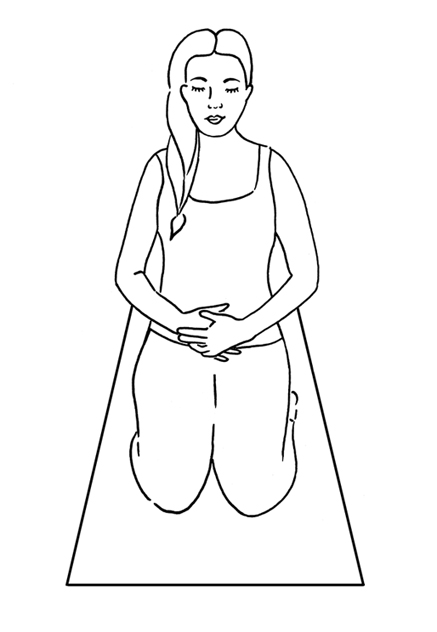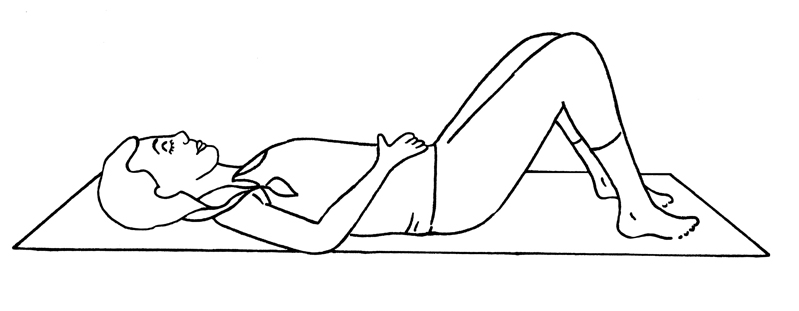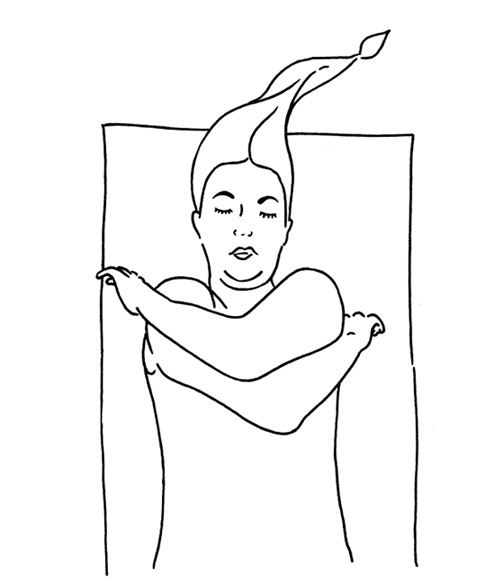Oxytocin is often dubbed as the ‘love hormone’ and offers many benefits, especially for women.
The role that the hormone oxytocin plays in birth and motherhood is generally well understood: it facilitates labour contractions and supports the process of breastfeeding. Oxytocin is sometimes called ‘the bonding hormone’ as it’s involved in supporting our connection with our children—our mothering instincts—and also when we have sex.
Oxytocin also serves as a wonderful antidote to the stress response as it lowers your blood pressure as well as decreases the hormone cortisol which is responsible for the fight-or-flight response.
It’s perhaps lesser-known that any kind of touch can increase your oxytocin levels, which is in turn associated with an increase in feelings of wellbeing, relaxation, trust and connectedness.
You can unleash these benefits for yourself with the simple power of touch within a gentle, feminine yoga practice.
The Tend and Befriend Response
To fully appreciate the role oxytocin plays in touch (and yoga) it’s helpful to first understand an important and unique, and generally female, physiological response to stress that expands the idea of ‘fight or flight’. This is called the ‘tend and befriend’ response. It’s the missing link when we talk about the ‘fight or flight response’.
The ‘fight or flight’ response is a term used to explain how we generally respond to something stressful or threatening in our lives. It’s what we tend to do when the stress hormones, cortisol and adrenaline, are elevated due to a stressful event or situation. More accurately it should be called, ‘the fight, flight, freeze, or tend and befriend response’. That’s because depending on the person and the situation some people will face and ‘fight’—either figuratively or literally, others will ‘flee’—again, figuratively or literally, while others will ‘freeze’, unable to fight or flee, and others still will feel the urge to talk their way out their stress—‘tend and befriend’.
Yep, that’s us, gals! One of the best ways women know how to deal with stress is to talk and connect with loved ones.
Studies have shown that women are more likely to respond to stress by going into nurturing mode and this has benefits for both ourselves and our loved ones.[i]
The ‘tend and befriend’ response is associated with a natural increase in oxytocin which is a very effective way in reducing the negative effects of that pesky cortisol (stress hormone). Apparently, women’s higher levels of oestrogen are also associated with their higher levels of oxytocin.[ii] That doesn’t mean though that men can’t benefit too by opting for connection and soothing behaviour, rather than aggression, isolation or inaction when faced with a stressful situation.
Self Compassion and oxytocin
Dr Kristen Neff is a pioneering teacher and researcher in the field of Mindful Self Compassion and she suggests that when we engage our ‘tend and befriend’ response to stress, or what she refers to as the ‘mammalian care-giving system’, we naturally employ the nurturing tools of touch and soothing words to calm ourselves or others.[iii]
It’s well known that touch, especially massage [iv] can induce the relaxation response. But did you know that self-touch can also help calm and soothe you?
Dr Neff recommends that when you’re feeling distressed try giving yourself a ‘warm hug, or tenderly stroke your arm or face, or gently rock your body.’[v] She adds that the intention is equally important and that we ‘make a clear gesture that conveys feelings of love, care and tenderness’. This is because thoughts and emotions have the same effect on our bodies whether they’re directed to ourselves or to others, she says, and she goes on to explain that self-compassion can be a powerful trigger for the release of oxytocin.
Self-touch in your yoga practice
In terms of your yoga practice, this all means that it can be beneficial to practise gestures or what I call, ‘feminine mudras’, that involve gently touching your body.
Simple, ritualistic gestures that are repeated often—before, during and at the end of your practice—help you come home to yourself. Gently placing your hands on specific parts of your body, as you breathe deeply and focus your intention in a self-compassionate way, is soothing and calming, helping to elevate your oxytocin levels.
It’s such a simple and effective practice!
Here are some of the ‘feminine mudras’ and other oxytocin-inducing self-touch practices that I introduce in my book Moving with the Moon: Yoga, Movement and Meditation for Every Phase of your Menstrual Cycle and Beyond.
Figure 1. Hands to Heart Mudra

Figure 2. Womb Mudra

Figure 3. Heart-Womb Mudra

Figure 4. Constructive Rest Posture
Resting in Constructive Rest Posture is soothing, grounding and relaxing especially if you combine it with the Soft Belly Breath (deep abdominal breaths).

Figure 5. Breast Self-Massage
Breast Self-Massage is very nurturing and healing and a great way to connect with your ‘heart-centre’ self / other loving energy. I explain in detail in my book ‘Moving with the Moon’ some ways to do this practice.

Figure 6. Savasana Self-Hug
Giving yourself a hug before Savasana is a great oxytocin boost!

Endnotes
[i] “This tending, or nurturing behaviour serves to benefit both the mother and the offspring, ensuring survival and health” (Field, 1995). See: http://www.personalityresearch.org/papers/mccarthy.html
Also, an article in Psychology Today (see: https://www.psychologytoday.com/au/articles/200009/tend-and-befriend) states: “Research by psychologist Tiffany Field, anthropologist Jay Kaplan and others shows that tending young and affiliating with friends dramatically reduces stress in humans and other animals, resulting in improved immune function, mood and a host of other rewards.”
[ii] “Estrogen has been found to increase the effects of oxytocin already in excess in females as compared with males.” See: http://www.personalityresearch.org/papers/mccarthy.html
[iii] See: https://self-compassion.org/the-chemicals-of-care-how-self-compassion-manifests-in-our-bodies/
[iv] “Normal health and immune functioning has also been correlated with touch and massage in infants.” (Field, 1995). See: http://www.personalityresearch.org/papers/mccarthy.html
[v] See: https://self-compassion.org/the-chemicals-of-care-how-self-compassion-manifests-in-our-bodies/
Ana Davis, Founder and Director of Bliss Baby Yoga, has a passion for a feminine approach to yoga, and supporting women with yoga through all ages and stages of their life. Ana is the author of the popular book, “Moving with the Moon – Yoga, Movement and Meditation for Every Phase of Your Menstrual Cycle and Beyond”. Ana has collaborated with Bliss Baby Yoga fertility specialist yoga teacher Rosie Matheson to create our Online Level 1 Yoga for Fertility Teacher Training. She is also the lead trainer on our popular Online Prenatal & Postnatal Yoga Teacher Training Course and Online L1 & L2 Restorative Yoga Teacher Training courses, and offers private mentoring and yoga sessions online, and online yoga classes.
Mindful Self Compassion and Restorative Yoga is a topic that Ana has included in our Online Level 2 Restorative Yoga Teacher Training course.
Illustrations by Sophie Duncan www.deerdaisy.com
Further Reading related to this topic:
- How Yoga Can Support Postnatal Mental Health (Including Three Simple Practices) by Maria Kirsten
- Prenatal Yoga for Anxiety (including Sequence) by Shannan O’Neill
- Extended Exhalation Breath with Lauren Tober (VIDEO)
- Yoga’s Sweetest Nectar: Yoga Nidra by Ana Davis
- Ayurvedic Self Massage: A Lush Daily Ritual for Women by Ana Davis


Comments are closed.